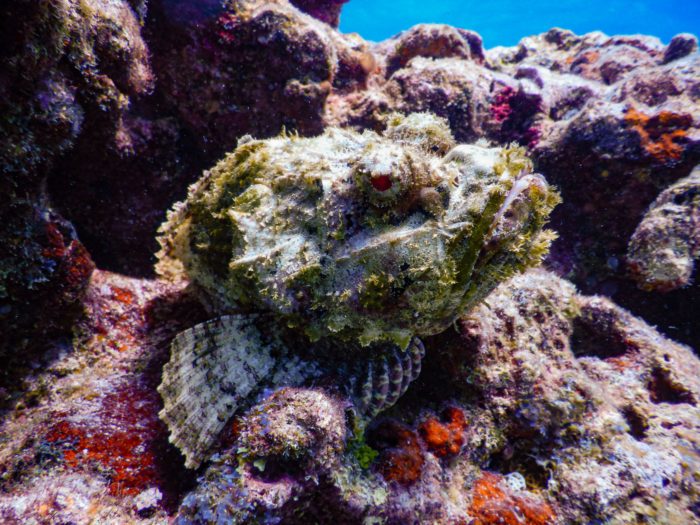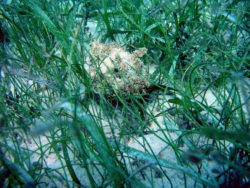
Sea Wonder: Scorpionfish

Photo Credit: Tiffany Duong
Scorpionfish (Scorpaenidae sp.) are slow-moving bottom dwellers that are quick to strike when unknowing prey pass them by!
Appearance
Scorpionfish are smaller fish that can reach lengths ranging from seven to 17 inches with a maximum weight of about three pounds. Their distinguishing features include skin that has a feathered texture and mottled brown or yellow patterns of color (in some rare cases they are also red or orange) that helps them blend into their rocky bottom or reef environments. Their pectoral fins are sometimes more colorful than the rest of their bodies, with green patches or colored blotches that are visible when these fins flare out. Atop their dorsal fins are sharp, venomous spines, and at the end of their bodies are flat, paddle-like tailfins.
Diet and Habitat
Scorpionfish are commonly found in the Indian and South Pacific Oceans where water temperatures are temperate, specifically in shallow coral reefs and rocky areas at depths between about 15 and 180 feet. Some species, like the spotted scorpionfish, are found in the Western and Eastern portions of the Atlantic Ocean and the Gulf of Mexico. In the Western Atlantic we find scorpionfish from the coast of Massachusetts to Bermuda and all the way down to Brazil. In the Gulf of Mexico we observe the scorpionfish from Florida, along the southern states of America, the eastern coast of Mexico, and down to the Central and South Americas. In the Eastern portion of the Atlantic, we see scorpionfish near the coast of Angola, Africa and St. Helena, an island off the coast of Africa. Sanctuaries in which we might find scorpionfish include the Florida Keys and Flower Garden Banks off the coast of Texas.
Known as ambush predators, scorpionfish lie and wait while unsuspecting prey swim near and then quickly strike, using their large mouths to vacuum in and swallow prey in an instant. In some cases, they can use their poisonous spines to pierce a predator’s skin and inject paralyzing venom into their target. Their diets vary depending on where in the habitat range they live, but a scorpionfish diet is usually comprised of smaller fish, mobile invertebrates like snails, and crustaceans. They are, for the most part, nocturnal predators due to the fact that decreased light availability can help them remain undetected by their targets.
Scorpionfish also have to be on the lookout for their own predators, which include sharks, rays, eels, and larger fish like mutton snapper. Parasites and associated disease are also a natural ecosystem-based threat to individual scorpionfish.
Life History
Scorpionfish are oviparous reproducers, meaning adults spawn by releasing gametes (eggs and sperm cells) into the water column for fertilization. Fertilized eggs float near the water’s surface until they hatch, and scientists know little else about the rest of the fish’s life cycle until adulthood.
Scorpionfish are usually solitary and don’t migrate as long as food is readily available. Scientists aren’t sure how long  scorpionfish can live or what their average lifespan is due to the difficulty in studying these fish and the challenges present in raising them in a lab setting.
scorpionfish can live or what their average lifespan is due to the difficulty in studying these fish and the challenges present in raising them in a lab setting.
Threats and Conservation
Scorpionfish aren’t commonly a target for fishing but do sometimes end up caught unintentionally as bycatch. They are edible but not commonly seen in stores or on menus. Thus, fishing isn’t a major threat to scorpionfish populations.
While scorpionfish are not listed as vulnerable, threatened, or endangered, changes in coral reef habitats in the ocean may be a threat to them in the future. These include ocean acidification, climate change, overfishing, and pollution, all of which can affect the scorpionfish’s environmental conditions, prey availability, or habitat quality.

 scorpionfish can live or what their average lifespan is due to the difficulty in studying these fish and the challenges present in raising them in a lab setting.
scorpionfish can live or what their average lifespan is due to the difficulty in studying these fish and the challenges present in raising them in a lab setting.